Art Fairs
Kenny Schachter Declares Basel the New Art Hajj
The museums in town are worth the trip alone.
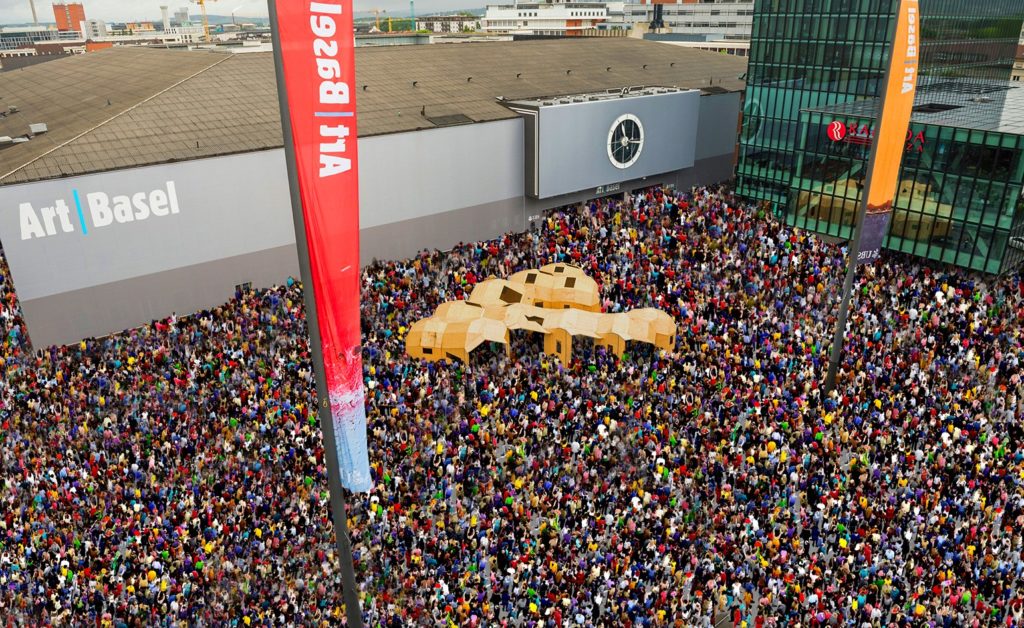
The museums in town are worth the trip alone.

Hajj is the annual pilgrimage to Mecca, a religious duty for Muslims to fulfill at least once in their lifetime, as long as physically and financially fit and capable of supporting their families in their absence. Basel is the art equivalent, other than the prerequisite of being physically and financially capable of undertaking the journey, or for that matter supporting others in their absence. Illiquidity never got in the way of an avid collector where deals are cemented by nothing more than the exchange of a few words with payment terms always at hand. What keeps the art world afloat is the religious buying of art. Amen.
Basel is bisected by the Rhine, an aggressively flowing river that when full, is fast, ferocious and has claimed many lives. Art Basel is an event not without concomitant perils due to the unparalleled intensity of the task at hand: the consumption of institutional amounts of art and alcohol at the unending string of dinners and parties. More on the extracurricular festivities later but overheard in the bar on the very first night was a rich and successful dealer and his rich and successful speculator friend contemptibly offering a random young woman $100,000 to jump into the river and be fetched fifty-feet downstream by the arrogant pair—chivalry lives.
The museums in town are worth the trip alone. Two Basel based pharmaceutical companies, Novartis and Roche, comprise a disproportionate percentage of the capitalization of the German stock exchange, which helps account for why there are more masterpieces per mile in Basel than just about any other municipality its size and beyond. Art is an emotional drug in itself for many in town this week, and let us not forget the clinically proven medicinal effects of being engaged with art—less meds (sorry Novartis) and shorter hospital stays. It’s true, look it up.
The Bank of England’s chief economist said the UK’s long-term borrowing costs were at their lowest level in 5,000 years. What better way to push the boat out than ramping up art acquisitions (unless it sinks)? Leveraging of galleries, collectors and dealers is such a bustling trend perhaps Basel should open a finance division to help galleries pay for booths.
Another development in this year’s fair, now in its 47th year, is the increased Chinese presence, of which less than 25% of 125 would be considered serious buyers of contemporary art. With a population in excess of 1.3 billion people, I guess things could only pick up. This coincided with my first deal in the region—selling an extra hotel room I had due to (what I thought was the luck) securing a coveted room in the historic Grand Hotel Les Trois Rois.
Allow me an aside, only a few weeks ago I represented a BBC TV program entitled The Bankers’ Guide to the Art Market (airing later this month) at the Hay Festival, a writers gathering in Wales in its 29th year, like Glastonbury for brainiacs. The show, prominently featuring Adam Lindemann among others, is a tongue in cheek send-up of the market, feeding into popular global contempt for contemporary art prices. Though I’m barely in the show, I was little prepared for the national outcry that resulted from my seemingly innocuous comments on the panel. Oops.
When I teach (at the University Zurich), I consider it an academic free port for the sheltered exchange of ideas about art. I thought I killed it discussing my role in the market, how I’ve involved my kids, and passion for collecting, dealing and writing about it all. And I might have mentioned an incident evincing the shenanigans involved on the trading floors of the auction houses, the still-wild frontier.
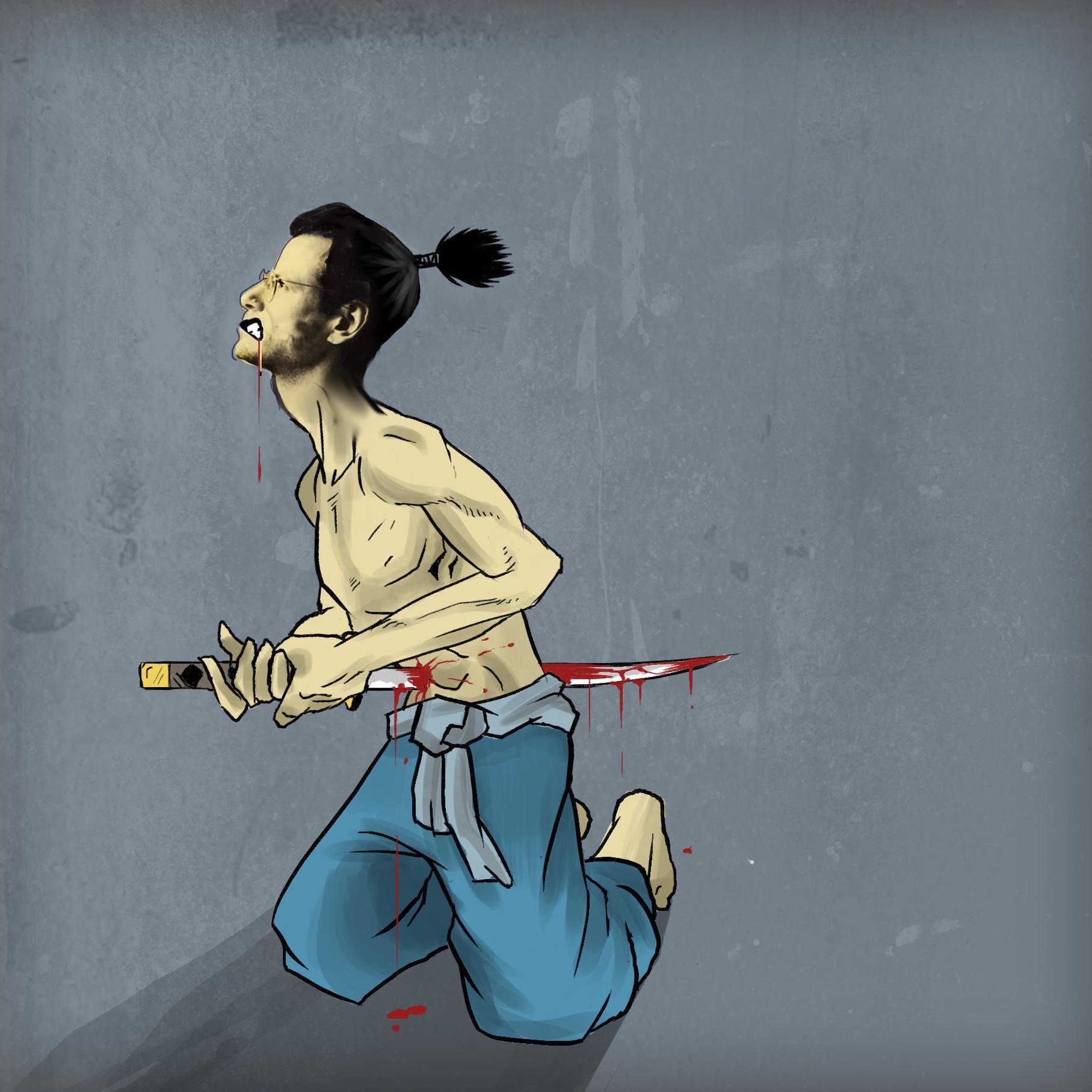
Courtesy of Kenny Schachter.
Two days later, the headline on page three of the Times blared, “A hotbed of corruption: insider gives art auctions a hammering”. What was meant to be “not for broadcast” was splashed all over the Telegraph, too. Had the Daily Mail delivered on their promise to detail specifics of the transaction I referred to, I shudder to think of the repercussions—so did my pal involved in the auction lot when I had to inform him of the unanticipated coverage. Professional seppuku.
The Grand Hotel Trois Rois, also known as the Drei Könige or Three Kings, originated in 1681, as a stopover for itinerant merchants involved in trade along the river. Some things never change. During the fair, the hotel resembles an (exorbitantly) expensive art dorm with contiguously aligned balconies so close you can see into the good eye of many an art dealer.
In the midst of my stay, my co-star Adam Lindemann checked in directly next-door; of course upon discovering this, he immediately had to barge in to ensure his was bigger, which of course it was. (For the prurient among you, I’m alluding to his room.)
Basel fixture Peter Brant is an art lifer who sees a Warhol work corporeally different than the way you or I do, such is the extent of his experience since his teens. Bumping into him, in this instance at Chez Donati’s, five owners ago said to have been one of the best Italian restaurants outside of Italy, is always a treat. This was no exception. Brant began railing against the recent rapid price inflation of certain relatively young artists he collects and finished excoriating the Warhol estate for their complicity in attempting to sell an ugly rejected painting he said was stolen by Andy’s housekeeper (that bought-in recently at auction). Call it a Brant rant, and I count myself fortunate to have had the earful, as there’s always something to learn.
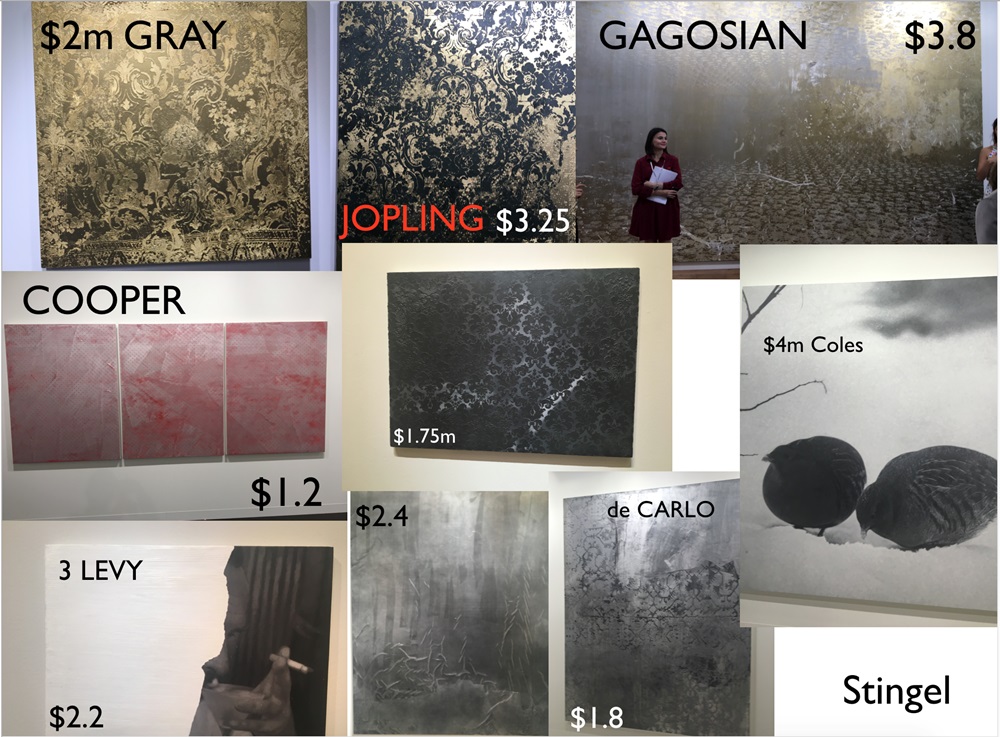
Courtesy of Kenny Schachter.
Back at the bar at Three Kings, where it always ends in a solid cube of bodies (this is all before the fair kicked off), scruffy Keanu Reeves was making his way through the thick crowd, perhaps he’s representing Adrien Brody’s latest paintings. A mega collector angrily snapped at his wife because she didn’t view their collection as an investment, while a gallerist on the other side of the couch spitefully foretold the inevitable collapse of a fellow London dealer (whom I know to be solvent), due to his alleged over-leveraging. Like a ball of intertwined worms under a rock, cheers!
The venal gossip, fueled by flowing booze (and other stuff I’d gather), mostly dissolves in a fog—I need a stenographer to tag along next time to transcribe all the juice. Aside from a drunken dealer, a deal may occasionally fall into your lap (if cogent enough), like the Stingel I just got an offer on.
Liste is the only alternative fair I’ve visited with a maddening, claustrophobic layout that challenges and obfuscates instead of encouraging measured looking. Besides, I’m not sure I retain (if I ever had) the capacity to discern the criteria of good new art. What I can recognize is the general sense of elation and euphoric buzz being celebrated—how much was bought is another issue impossible to calculate with certitude.
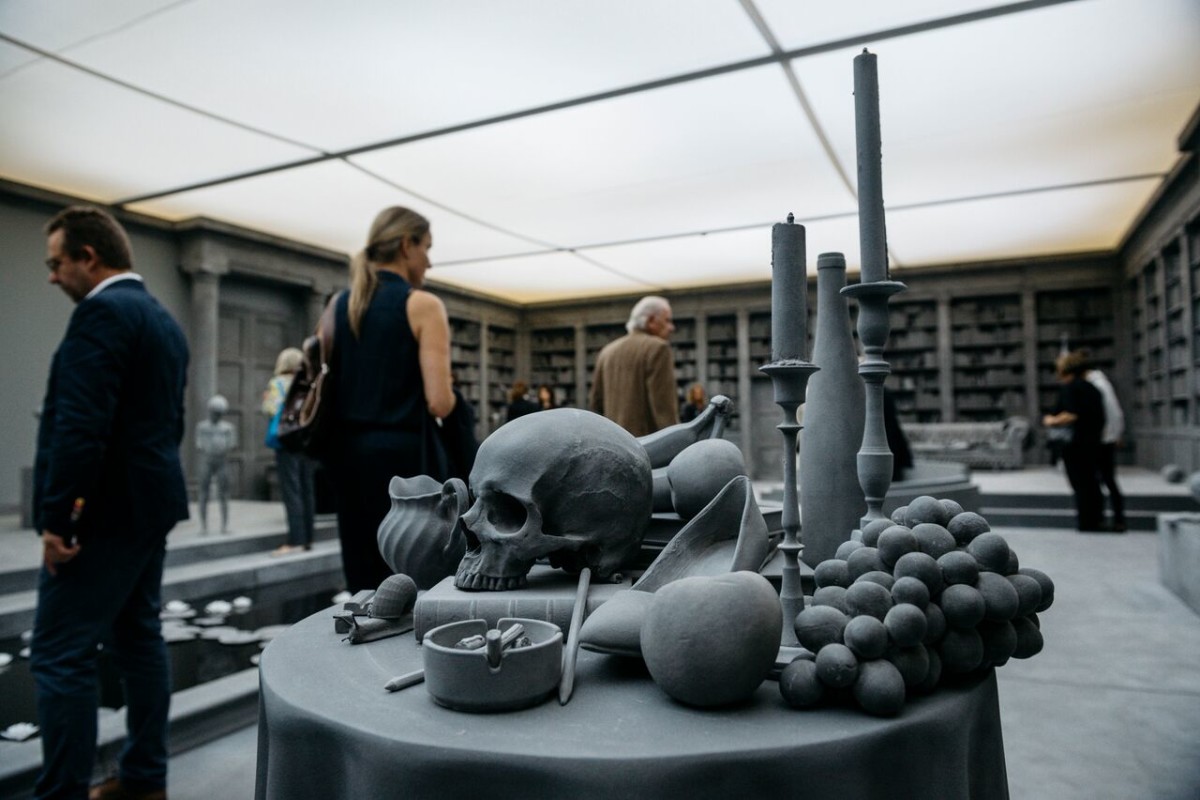
Hans Op de Beeck, The Collector’s House, (2016). Courtesy of Marianne Boesky Gallery, Galleria Continua, and Galerie Krinzinger, Art Basel Unlimited, 2016.
Art Basel Unlimited
Do you think there is Art Fair Art (AFA), an evolutionary mutation of the practice caused by the confines of the standardized three walls of the ever-present booths? AFA is more contained and beatific than you will otherwise see in a museum or gallery, even when it’s trying to be subversive; under the main tent it all comes off as innocuous and decorative, and/or investment grade. To combat this, there was the officially sponsored Unlimited section, a curated mixture of the unwieldy, media infused, politically proactive and performance driven (thoughtfully organized by New York-based Gianni Jetzer). It’s an impressively staged and scaled spectacle as an antidote housed in a cavernous hall enjoining the fair.
Mike Kelley’s Reconstructed History, from 1989, was a series of 50 actually very small, defaced textbook pages with cartoonish, adolescent images of explicit sex and bathroom wall humor; a rather exceptional piece and outstanding that it sold on the opening for $1.5 million. Hans Op de Beeck’s The Collector’s House (2016) is an all-over environment not dissimilar (enough) from Sandy Skoglund’s extravagantly constructed tableaux since the 1970s.
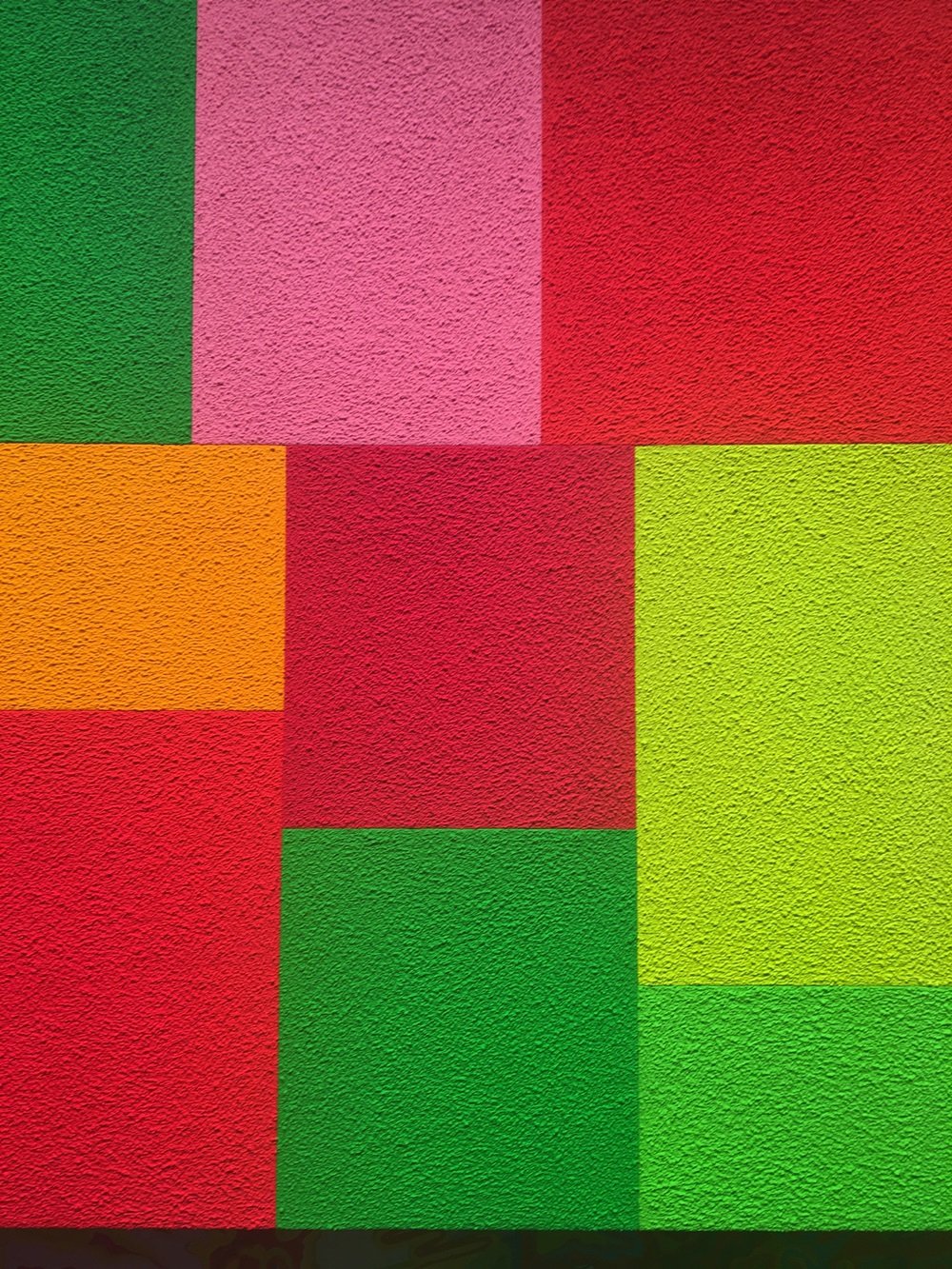
Peter Halley. Courtesy of Kenny Schachter.
Wolfgang Tillmans’s photographic installation of nonchalant depictions of his coterie of friends combined with protesters, activists, and conceptual abstractions was made more poignant due to the worldwide social and politically irresponsible and intolerant society we reside in. He will be the Beyeler’s first photographic exhibition. Another artist I don’t quite get is Chris Martin; his Unlimited painting was seemingly unlimited in magnitude but better than James Rosenquist’s, which while cruise ship big, was about as interesting as something you’d find onboard. Elmsgreen & Dragset, from Denmark and Norway respectively, contributed a sound piece from 2015, simplistically entitled Secondary, comprised of the voices of two auctioneers negating each others’ shouting prices. As Warhol would characterize it: gee.
In what amounted to nothing less than a hot-colored stucco provocation, Peter Halley threw down the gauntlet with his group of paintings boldly reclaiming territory from newcomer and market darling Alex Israel. Did someone say comeback?
With the art film attention span of a flea, I didn’t last long in any of the stifling rooms housing more videos than a Blockbuster (if anyone recalls the once-mighty rental chain).
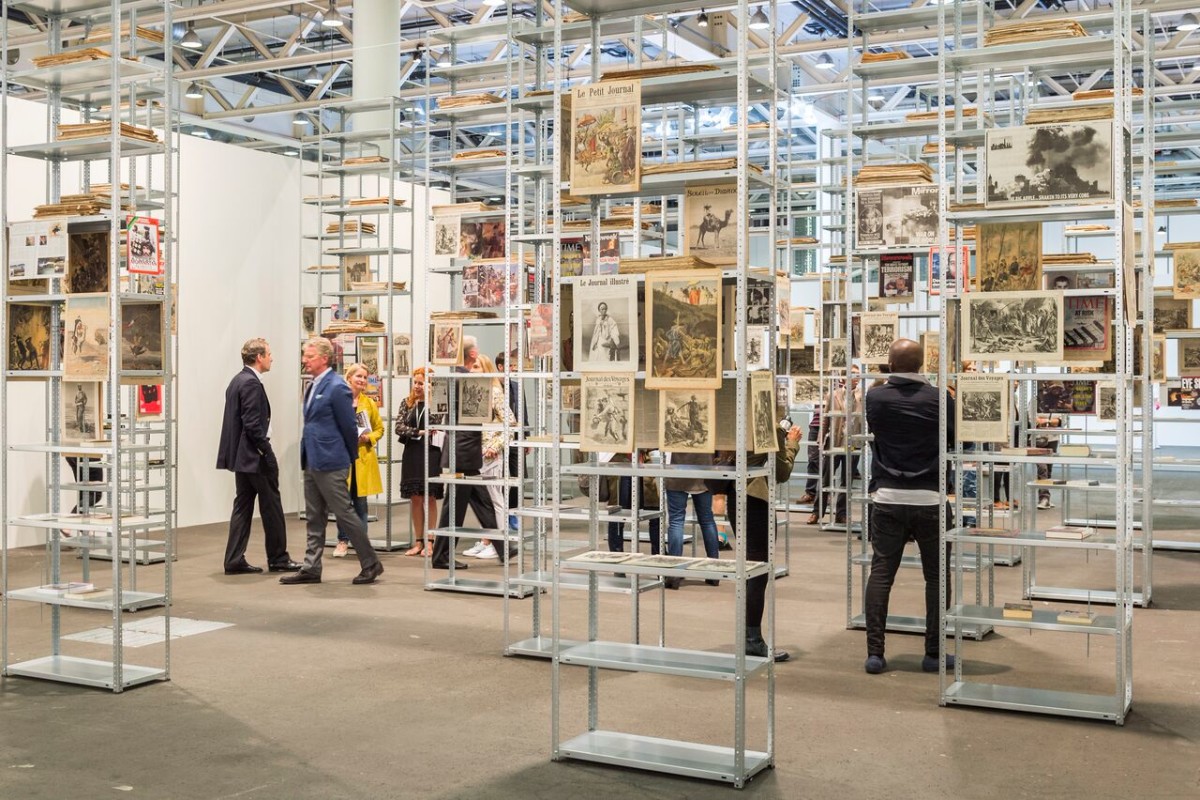
Kader Attia, Galerie Nagel Draxler. Courtesy of Art Basel 2016.
Main Basel Fair
I always shy away from attending the very onset of any fair for apprehension of being trodden by the Prada pumps-and-loafers set intent on being first, and given to unruliness when it comes to queuing up…for anything. Stuck in the rain, with a line stretching around the block, it just as easily could have devolved into another Brexit riot à la the World Cup (thankfully, nobody seems ready to secede from art just yet).
Besides, I have a fear of terrorism; with the addition of metal detectors for the first time, I’m not the only one. In fact there were a handful of works dealing with the very topic, like Kader Attia’s The Culture of Fear: An Invention of Evil, 2013. Malignant behavior has been around forever, but certainly the level of dread has been exacerbated.
Upon entering midday I was overcome with dizziness, from the heat and stuffiness. Which reminded me of passing out in my booth of the (well named) Basel Miami design fair in Basel about ten years ago, and admitting myself into the hospital mid-event, leaving an unmanned booth—joyful memories. For a second, l felt a relapse due to the enormity of it all, the utter overload to take in as much as there is. Or maybe it was the idiots who insist on texting, Instagram-ming and downright dilly dalliers blocking passageway through some of the aisles. And I’m not sure I’d condone the use of ski poles I saw a few couples trekking with; can that be a good idea? A frequent refrain I heard from acquaintances upon entering was: “You look lost.” Yes, the confused look plastered across my face like a pet gone missing was a frequent occurrence—attributable to my dismal sense of direction. Whenever I’d focus on something that caught my attention (regularly) I’d emerge as if blindfolded.
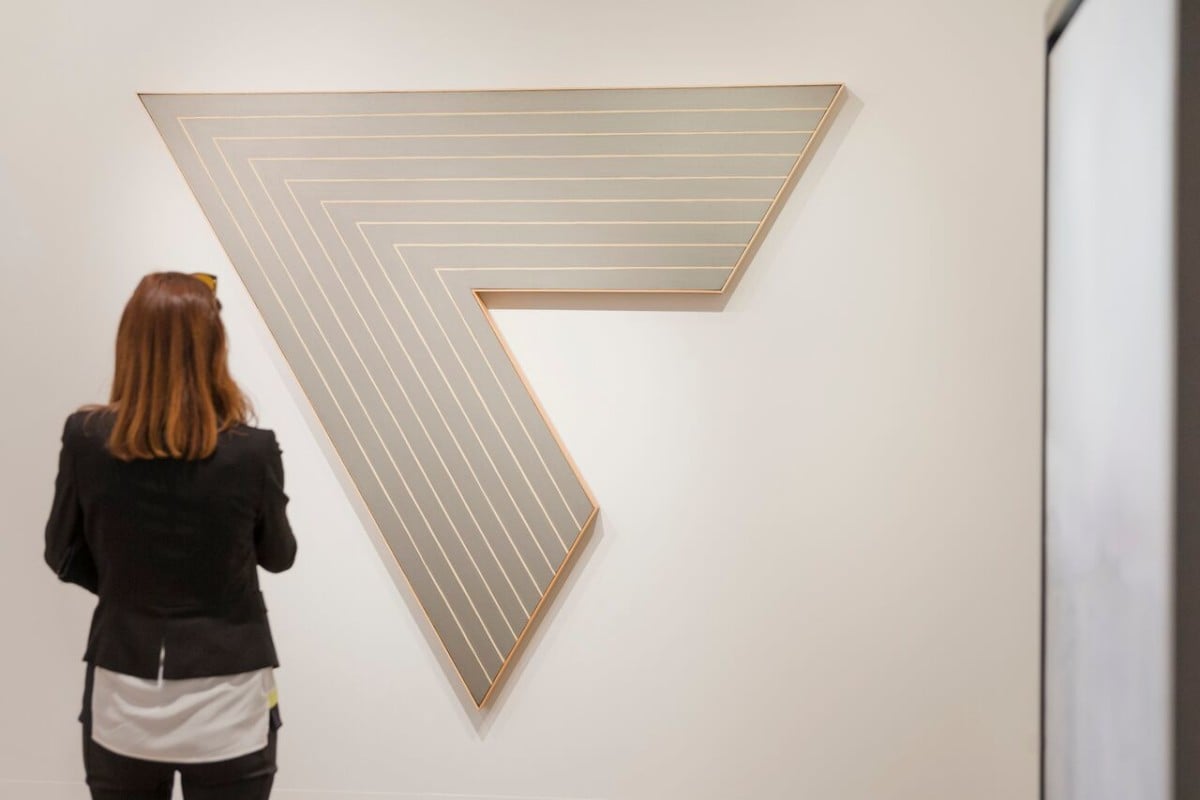
Dominique Lévy Gallery booth. Courtesy of Art Basel 2016.
Every year it’s a handful of marked market movers that add to the mega wattage of the selling floor making the big contemporary booths vibrate; obvious things by obvious artists at obvious galleries, you get the picture: Zwirner, Hauser, Larry G, and Dominique Lévy dominate the state of affairs. This iteration it was Sigmar Polke, Rudolf Stingel, Mike Kelley, and the Wade Guyton and Christopher Wool sideshow.
Guyton has an exhibition at Le Consortium in Dijon opening next week and to test collectors’ mettle exhibited three identically oversized (ten feet plus) computer printed interior studio shots, all of which were sold at $600,000 a pop from Petzel, Chantal Crousel, and Gió Marconi galleries. The highly anticipated new works are self-reflexive navel gazing that I happen to be incredibly drawn to, especially the fiery light. I curated Wade in a group show in 1996 before he had a printer.
Having so many veritably caged dealers at your mercy, what better time to blast them with endless pricing queries. I will share a bit of a laundry list, but much has already been recorded. On the secondary front, Dominque Lévy’s three Stingels were priced at $2.4 million, $2.2 million and $1.75 million, and ranged from an abstract “Instruction Painting” to a pair of small semi-abstract portraits. Richard Gray sold a 50-inch-square gold wallpaper painting for $2 million as well. Not to be outdone, Jay Jopling sold gloomy black-and-gold wallpaper for $2.8 million; however, it had a $3.25 million asking price. A good time for discounts.
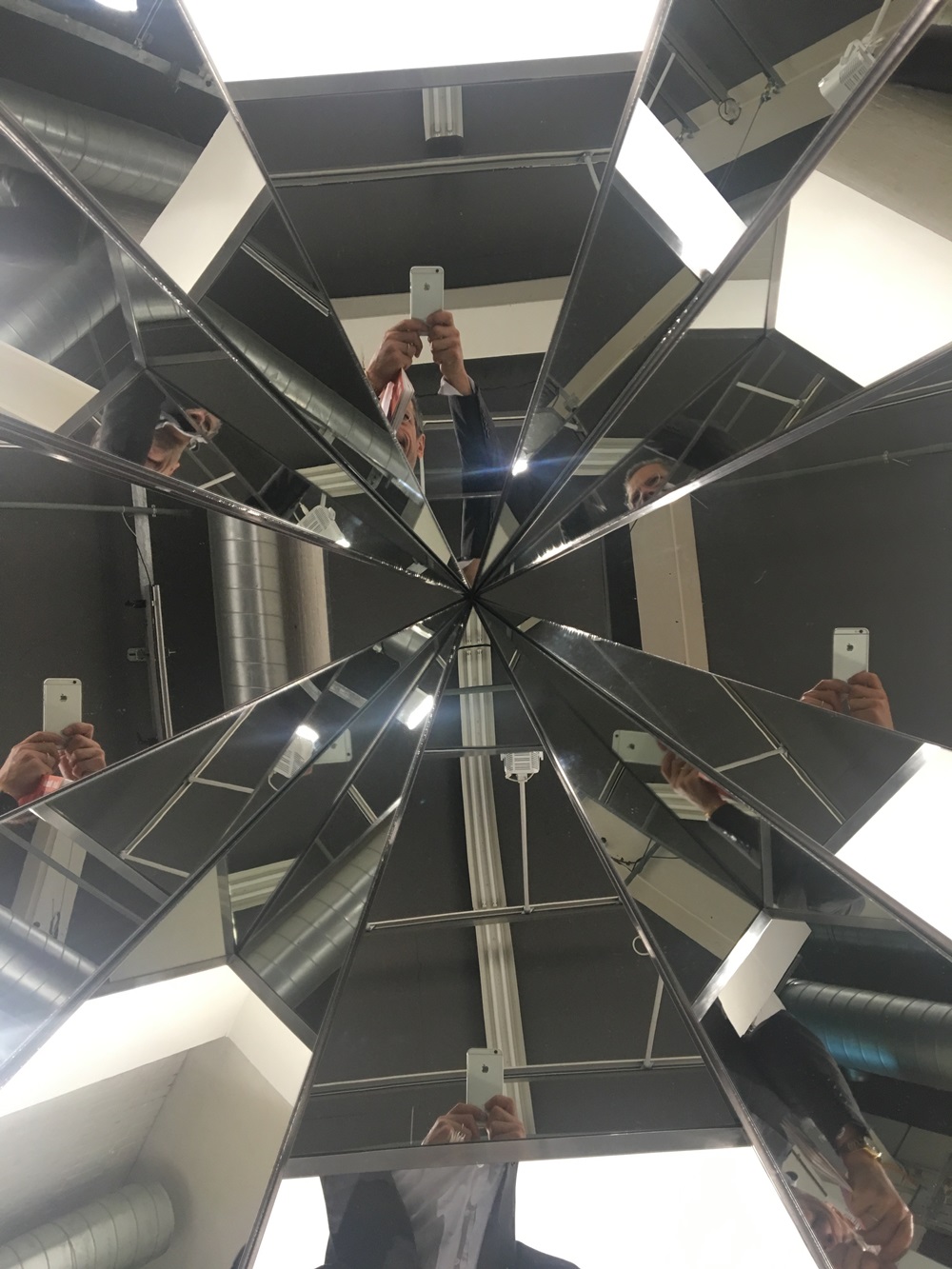
Robert Smithson. Courtesy of Kenny Schachter.
Primary dealers Sadie Coles sold her big bird painting swiftly with a $4 million asking price, Massimo De Carlo sold his distorted abstract/patterned work for $1.8 million, Gagosian sold his ginormous gold patterned work with an asking price of $3.8 million. And Paula Cooper sold a red dotty abstract triptych for $1.2 million. That’s not taking into account the few I missed. I read Stingel doesn’t like his prices noted; I hope he understands I’m simply a massive fan, albeit a curious one.
There was no less than a Polke plethora with Zwirner making a tremendous impact with a rare, if ever to the market, group of works. The largest was widely reported sold with a €6.5 million ask, an unusual painting dealing with the French Revolution, unsold at €4.5 million, and an abstract resin painting around €2 million. And plenty of others throughout.
Fergus McCaffrey had a 1983 diptych that I last saw at the Cologne fair with a $1.3 million price tag this go-round. This mucky painting has had a sordid history, an example of what I call market art: works publicly sold again and again (and again) destined to be frozen in a nether land of endless transactions like the film Groundhog Day.
In 1991 the Polke diptych bought-in at Christie’s, with an estimate of $180,000-$250,000; in 1992, it bought-in at Sotheby’s, estimate $80,000-$100,000; then it had a respite before reentering the market in 2003 at Phillips with an estimate of $60,000-$80,000 and finally sold at $75,000 before heading back to the block again at Phillips in 2013 with an estimate of $600,000-$800,000, where it bought-in for the third time in its promiscuous life. The owner(s) of this painting have at least extended equal opportunities, failing at all the major auction houses.
Can someone love and rehabilitate this work? Maybe it sold and if so, I stand corrected, but I doubt it.
Camille Henrot was dotted all over the place, the soup du jour of the emerging market set. But highflying Henrot seemed to have emerged, in the aggressive pricing of her many abstract dull, overproduced deco-looking pieces anyway. At €200,000 each, all in editions of eight + four artist’s proof (what the hell is 4 APs about?) she was diluting her shares before our eyes. Yuck. James Cohan wins the prize for a stunning, covetous Robert Smithson display, starting at a few hundred thousand and never north of $1 million. He also had the best line asking me to characterize his booth as “an act of genius,” which it was, and ridiculously cheap. Lisson had an Ai Weiwei “unique” iron cast of a tree root for €400,000, as long as there is more than one tree stump, I’m having a premonition we’ll see more of these. In different colors, shapes, sizes, and priced accordingly.
This was possibly the best overheard conversation in an art fair or anywhere. A collector considering the paintings of Jonas Wood approached David Kordansky from Los Angeles and so began an epic exchange, which may single-handedly have encapsulated everything the general public has ever disdained about contemporary art and the gallery “system.” Refusing to even entertain a discussion on the potential availability of (Gogo stablemate) Wood’s in-demand, Hockney-esque, lush, LA-themed paintings, Kordansky repeatedly shooed the collector away like a nettlesome bug.
The guy then committed to loan a potential purchase to a museum, at which point the incredulous dealer recoiled like he stepped in shit and said: “You have to consistently buy all my artists. I sell Jonas’ work to the likes of Stevie Cohen, and Leo DiCaprio,” among others I couldn’t make out; are they our Medicis? We get what we deserve. Kordansky wouldn’t let go; he said the economic climate in no way deterred him from acting differently. I guess the buyer not knowing where the gallery was located didn’t help matters.
Mr. Collector spun around on his heels and said, “You’re a fucking prick!” Without missing a beat, Kordansky replied: “Don’t take it personally.” What fun, like a first row seat for a performance by the renowned Chicago improvisational comedy troupe Second City. It ended with the collector I began to commiserate with, who was hilarious in his own right, stating, “I’m not offended, I find it hysterical, but you’re still the biggest asshole I’ve ever met.”
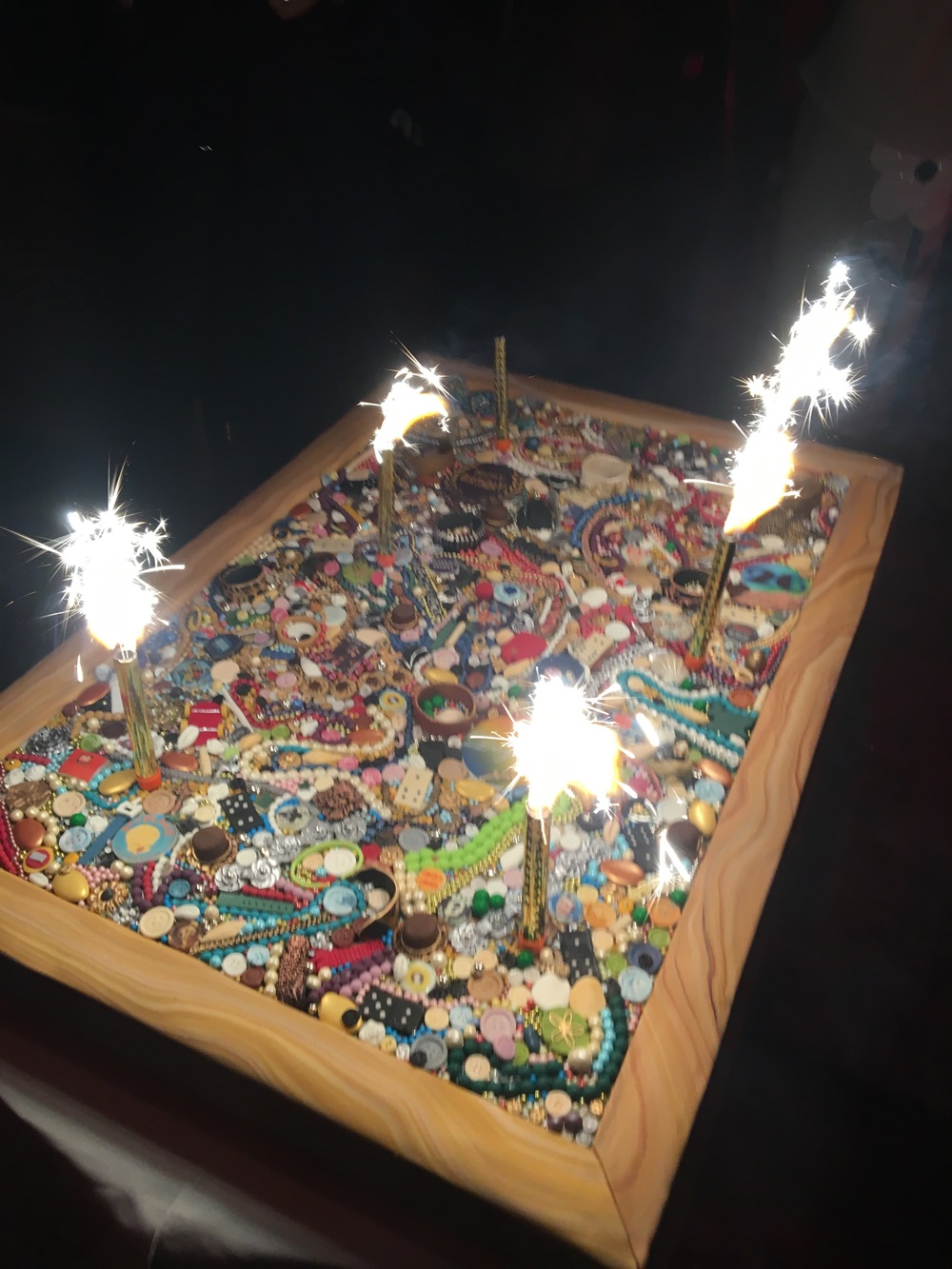
Mike Kelley Memory Ware cake. Courtesy of Kenny Schachter.
At a late-night birthday party for a young Kazakh upstart collector, I bumped into pumped-up Jay Jopling, who lavished me with his private schoolboy nastiness, to the effect that I was short and old (he’s the same age, though taller) before pleading with me for help selling a secondary Mike Kelley Memory Ware work he couldn’t move after the first (of two) VIP openings. Before I could come up with an appropriately obnoxious retort, they wheeled out the cake in the form of none other than a Kelley Memory Ware. Why would anyone read fiction?
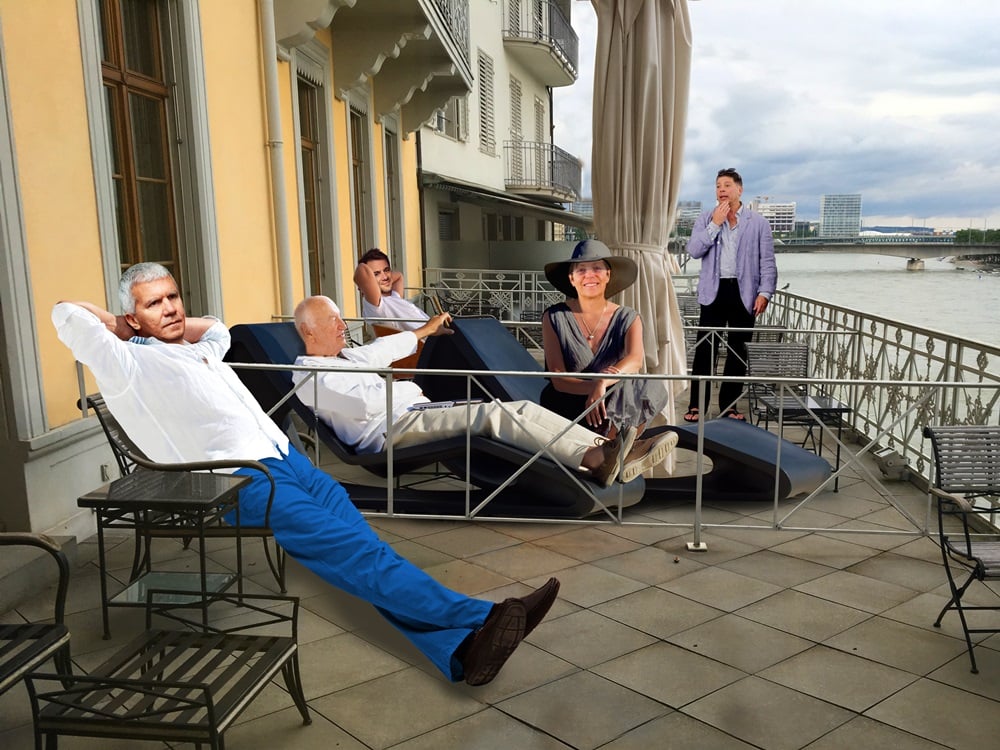
Courtesy of Kenny Schachter.
What a difference a day makes—by only the second day of the proceedings, it was like a leaky valve had sprung; there was a very noticeable dissipation of energy. I even spied maverick Swiss dealer Eva Presenhuber lost in a state of reverie in front of a hypnotic Ugo Rondinone target painting. I was stuck, having to remain to teach my Zurich class. From one second to the next, the town went back to bed. I can’t imagine it’s a happy place to be if you didn’t sell in the beginning; the market is less than non-forgiving if you get it wrong. By Friday and Saturday it could only be a living hell for the hapless left on.
On another note, I visited an exhibit staged at Mobel Transport, a city-state in the autonomous zone known as free port land. They should have their own currency and passport. I have seen the future and this is it; it saves you the effort/bother of moving and fretting about what to store or hang, all in one go. Who needs art fairs? Cut out the middle people and go to the source where more of the world’s cultural artifacts are housed than in the combined museums of the universe.
After an anxious feeling in the pit of my stomach for a week, I am relieved to call it a day. In art fair (or auction) mode I find I can barely read or exercise, it’s that all-or-nothing consuming force (literally, for some). I won’t say such doings are without frustration, yet at the least, heavenly from hindsight. What’s missing is the element of time and reflection, essential to the experience of actually experiencing art; fairs are not made for (too much) thinking. But there is not a more efficient manner to be exposed to the sheer quantity of what is regularly exceptionally great art (and people).
We live in difficult and uncertain social, political, and economic times. The only steady job left in the art world is as Richard Prince’s lawyer; but, after another vibrant and seemingly successful edition of Art Basel, we can all breathe a sigh of relief that we’re still in (big) business. Bring on the next fair.